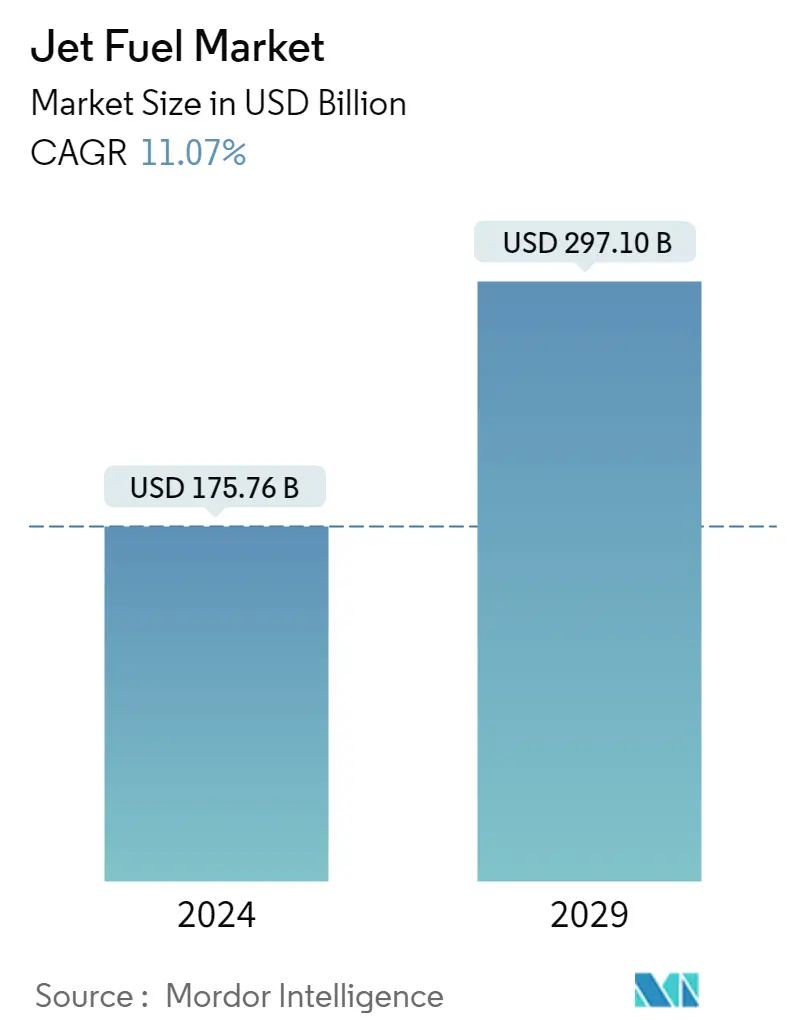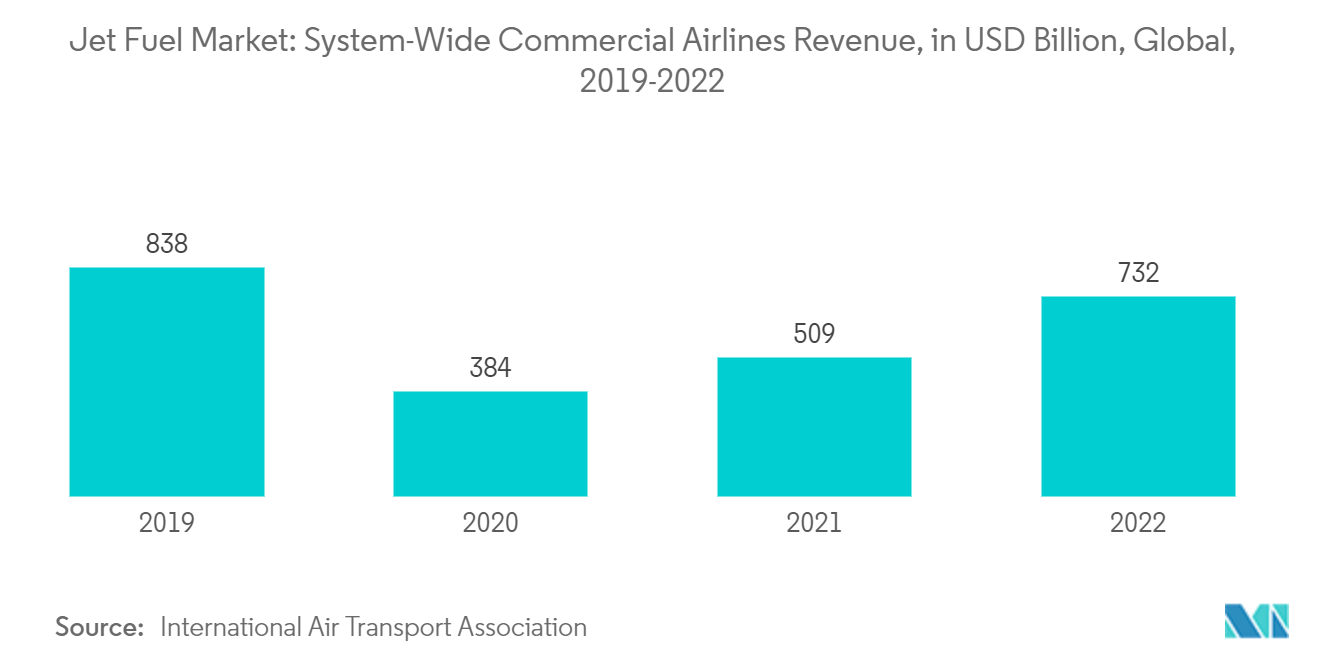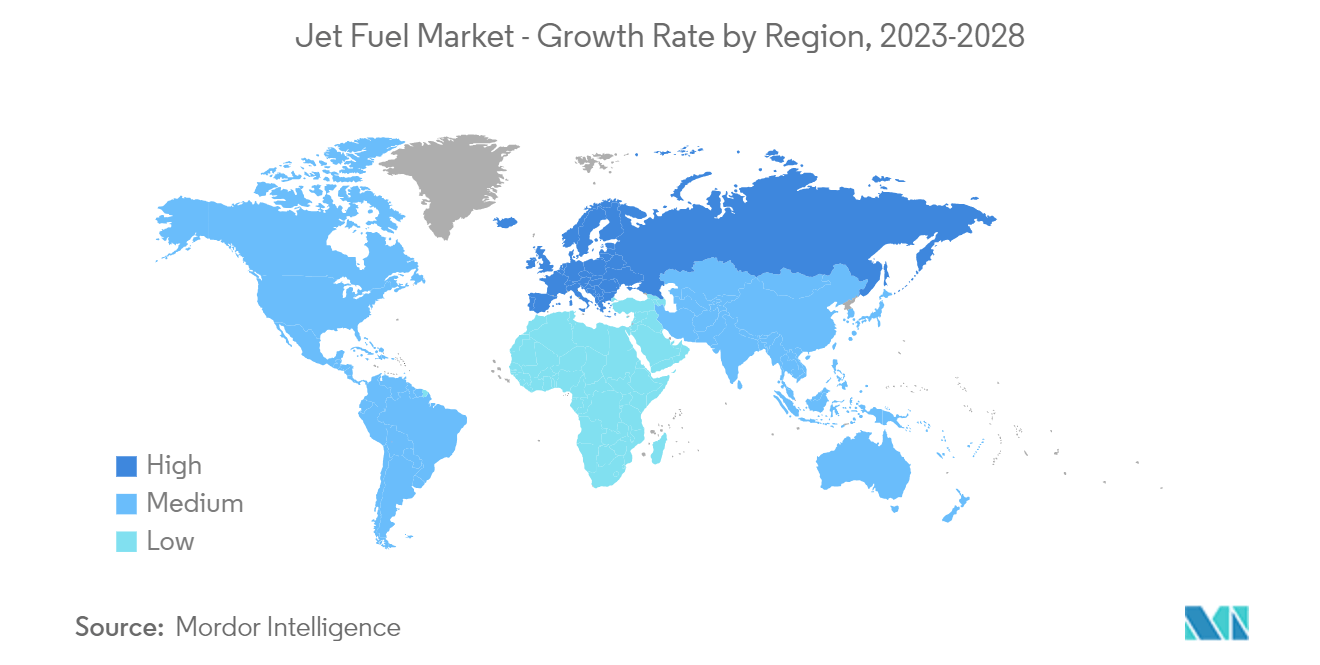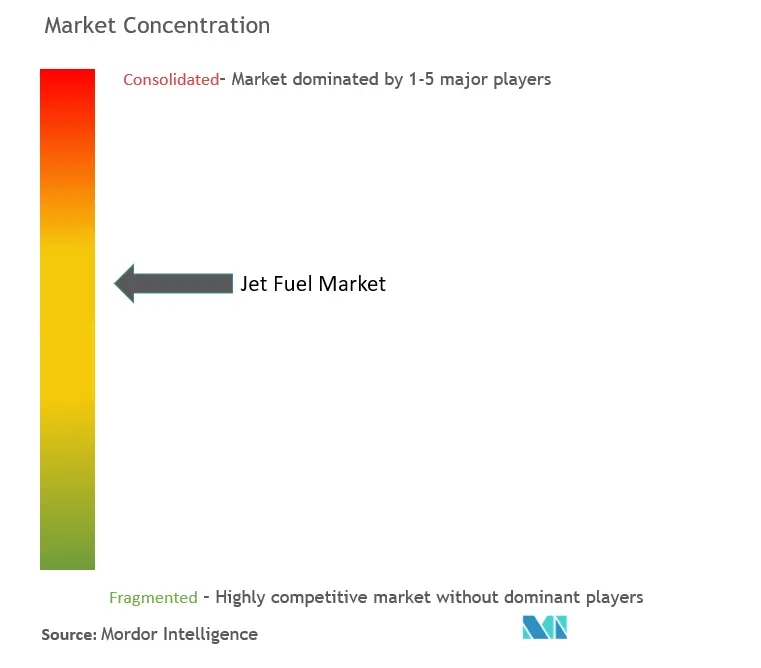Jet Fuel Market Size

| Study Period | 2019 - 2029 |
| Market Size (2024) | USD 175.76 Billion |
| Market Size (2029) | USD 297.10 Billion |
| CAGR (2024 - 2029) | 11.07 % |
| Fastest Growing Market | Europe |
| Largest Market | Asia Pacific |
Major Players*Disclaimer: Major Players sorted in no particular order |
Need a report that reflects how COVID-19 has impacted this market and its growth?
Jet Fuel Market Analysis
The Jet Fuel Market size is estimated at USD 175.76 billion in 2024, and is expected to reach USD 297.10 billion by 2029, growing at a CAGR of 11.07% during the forecast period (2024-2029).
- Over the medium period, the increasing number of air passengers, based on the cheaper airfare in recent times, improving economic conditions, and increasing disposable income, are expected to drive the market during the forecast period.
- On the other hand, the market can face hurdles in the coming years due to the high share of fossil-fuel-based jet fuels in many countries. They are responsible for the degradation of the environment.
- Nevertheless, the increasing concerns over emissions from the aviation industry led several governments worldwide to implement mandates that require a blending of renewable aviation fuel with conventional fuel types. It is expected to create significant opportunities for the companies involved in the market.
- Asia-Pacific dominated the market globally, as the region witnessed increasing passenger traffic, especially from emerging economies.
Jet Fuel Market Trends
The Commercial Segment to Dominate the Market
- Commercial aviation includes operating scheduled and non-scheduled aircraft, which involves commercial air transportation of passengers or cargo. The commercial segment is one of the largest consumers of aviation fuel, accounting for a quarter of the total operating expenditure for an airline operator.
- Air travel became more accessible than ever. In 2022, airfares, in real terms, averaged less than half of what they were in 1995. The airline network expanded to exceed 20,000 unique city pairs as per International Air Transport Association (IATA). Therefore, commercial airlines' growth is underpinned by the direct connection between cities, enabling the flow of goods and people.
- As per International Air Transport Association (IATA)'s World Air Transport Statistics 2022, in 2022, the global airline industry's passenger air traffic revenue amounted to USD 732 billion, a 43.81% increase compared to the previous year. Hence, as the number of passengers is increasing on commercial flights, the demand for aviation fuel is expected to increase, driving the market studied during the forecast period.
- Domestic aviation markets are more resilient than international ones, as control measures are typically less stringent within a country. However, As of 2022, international traffic started to catch up with domestic traffic, increasing from 24.6% of pre-pandemic levels in 2021 to 62.1% in 2022.
- Therefore, factors like ease of travel restrictions for domestic and international travelers will build a positive trend in air passenger traffic. These are expected to boost the demand for jet fuel in commercial applications over the forecast period.

Asia-Pacific to Dominate the Market
- China is one of the largest aviation fuel markets globally and one of the largest in terms of air passengers carried. As of 2022, domestic passengers in China were the second-largest in the aviation market after the United States (IATA).
- Routes to, from, and within Asia-Pacific are expected to witness an extra 2.35 billion annual passengers by 2037, for a total market size of 3.9 billion passengers. On a global level, the number of trips per person is expected to increase by 4-8% per year for many emerging countries. But it can be as high as 10-11% annually in China and India.
- In the coming years, China is expected to surpass the United States as the world's largest aviation market (defined as traffic to, from, and within the country). The re-balancing of the country's economy toward consumption is expected to support strong passenger demand over the long term.
- India is expected to take third place after the United States, surpassing the United Kingdom around 2024. Indonesia is expected to stand out, climbing from the world's 10th-largest aviation market in 2017 to the 4th-largest by 2030.
- Because of inconsistencies in virus management and outbreaks, regions had varying degrees of traffic growth in 2022 and early 2023. Notably, in the Asia-Pacific region, International travel lagged behind other regions and only began to pick up steam in March 2022, when fears over the Omicron variant abated.
- Therefore, with the increasing air passenger and air freight traffic in the region, especially from emerging economies such as India, Indonesia, and Thailand, the jet fuel market in Asia-Pacific is expected to witness huge growth over the forecast period.

Jet Fuel Industry Overview
The jet fuel market is moderately consolidated. The key players in the market (in no particular order) include Exxon Mobil Corp., Shell PLC, TotalEnergies SE, Chevron Corporation, and BP PLC., among others.
Jet Fuel Market Leaders
BP plc
Exxon Mobil Corp
Shell PLC
Chevron Corporation
TotalEnergies SE
*Disclaimer: Major Players sorted in no particular order

Jet Fuel Market News
- April 2023: Indian Oil Corporation intends to form a joint venture with US-based clean energy technology company LanzaJet Inc and numerous domestic airlines to produce sustainable aviation fuel (SAF). At USD 366 million, the proposed business will establish a factory to manufacture SAF using alcohol-to-jet technology at the state-run company's Panipat refinery in Haryana.
- March 2023: NREL regional analysis can aid in accelerating the production and delivery of sustainable aviation fuel. Sustainable aviation fuel (SAF), made from nonpetroleum sources such as trash and biomass, can reduce aviation greenhouse gas (GHG) emissions by 50% or more than fossil-derived jet fuel.
Jet Fuel Market Report - Table of Contents
1. INTRODUCTION
1.1 Scope of the Study
1.2 Market Definition
1.3 Study Assumptions
2. EXECUTIVE SUMMARY
3. RESEARCH METHODOLOGY
4. MARKET OVERVIEW
4.1 Introduction
4.2 Market Size and Demand Forecast in USD, till 2028
4.3 Recent Trends and Developments
4.4 Government Policies and Regulations
4.5 Market Dynamics
4.5.1 Drivers
4.5.1.1 The Increasing Number of Air Passengers
4.5.1.2 Increasing use of Aircraft in Defence Sector
4.5.2 Restraints
4.5.2.1 Environmental Regulations on Fossil-Fuel based Jet Fuels
4.6 Supply Chain Analysis
4.7 Porter's Five Forces Analysis
4.7.1 Bargaining Power of Suppliers
4.7.2 Bargaining Power of Consumers
4.7.3 Threat of New Entrants
4.7.4 Threat of Substitutes Products and Services
4.7.5 Intensity of Competitive Rivalry
5. MARKET SEGMENTATION
5.1 Fuel Type
5.1.1 Jet A
5.1.2 Jet A1
5.1.3 Jet B
5.2 Application
5.2.1 Commercial
5.2.2 Defense
5.2.3 General Aviation
5.3 Geography
5.3.1 North America
5.3.1.1 United States of America
5.3.1.2 Canada
5.3.1.3 Rest of the North America
5.3.2 Europe
5.3.2.1 Germany
5.3.2.2 United Kingdom
5.3.2.3 Italy
5.3.2.4 France
5.3.2.5 Rest of the Europe
5.3.3 Asia-Pacific
5.3.3.1 China
5.3.3.2 India
5.3.3.3 South Korea
5.3.3.4 Rest of the Asia-Pacific
5.3.4 South America
5.3.4.1 Brazil
5.3.4.2 Argentina
5.3.4.3 Rest of the South America
5.3.5 Middle-East and Africa
5.3.5.1 United Arab Emirates
5.3.5.2 Saudi Arabia
5.3.5.3 South Africa
5.3.5.4 Rest of the Middle-East and Africa
6. COMPETITIVE LANDSCAPE
6.1 Mergers and Acquisitions, Joint Ventures, Collaborations, and Agreements
6.2 Strategies Adopted by Leading Players
6.3 Company Profiles
6.3.1 Exxon Mobil Corp.
6.3.2 Shell PLC
6.3.3 TotalEnergies SE
6.3.4 Chevron Corporation
6.3.5 BP PLC
6.3.6 Qatar Jet Fuel Company
6.3.7 Allied Aviation Services Inc.
6.3.8 Bharat Petroleum Corp. Ltd
6.3.9 Gazprom Neft PJSC
- *List Not Exhaustive
7. MARKET OPPORTUNITIES AND FUTURE TRENDS
7.1 The Government Implementation of a Blending of Renewable Aviation Fuel with Conventional Fuel Types
Jet Fuel Industry Segmentation
Jet fuel or aviation turbine fuel is a type of aviation fuel designed for use in aircraft powered by gas-turbine engines.
The jet fuel market is segmented by fuel type, application, and geography. The market is segmented by fuel type into jet A, jet A1, and jet B. By application. The market is segmented into commercial, defense, and general aviation. The report also covers the market size and forecasts for the jet fuel market across major regions. Each segment's market sizing and forecasts are based on revenue (USD).
| Fuel Type | |
| Jet A | |
| Jet A1 | |
| Jet B |
| Application | |
| Commercial | |
| Defense | |
| General Aviation |
| Geography | |||||||
| |||||||
| |||||||
| |||||||
| |||||||
|
Jet Fuel Market Research FAQs
How big is the Jet Fuel Market?
The Jet Fuel Market size is expected to reach USD 175.76 billion in 2024 and grow at a CAGR of 11.07% to reach USD 297.10 billion by 2029.
What is the current Jet Fuel Market size?
In 2024, the Jet Fuel Market size is expected to reach USD 175.76 billion.
Who are the key players in Jet Fuel Market?
BP plc, Exxon Mobil Corp, Shell PLC, Chevron Corporation and TotalEnergies SE are the major companies operating in the Jet Fuel Market.
Which is the fastest growing region in Jet Fuel Market?
Europe is estimated to grow at the highest CAGR over the forecast period (2024-2029).
Which region has the biggest share in Jet Fuel Market?
In 2024, the Asia Pacific accounts for the largest market share in Jet Fuel Market.
What years does this Jet Fuel Market cover, and what was the market size in 2023?
In 2023, the Jet Fuel Market size was estimated at USD 158.24 billion. The report covers the Jet Fuel Market historical market size for years: 2019, 2020, 2021, 2022 and 2023. The report also forecasts the Jet Fuel Market size for years: 2024, 2025, 2026, 2027, 2028 and 2029.
Jet Fuel Industry Report
Statistics for the 2024 Jet Fuel market share, size and revenue growth rate, created by Mordor Intelligence™ Industry Reports. Jet Fuel analysis includes a market forecast outlook to 2029 and historical overview. Get a sample of this industry analysis as a free report PDF download.
